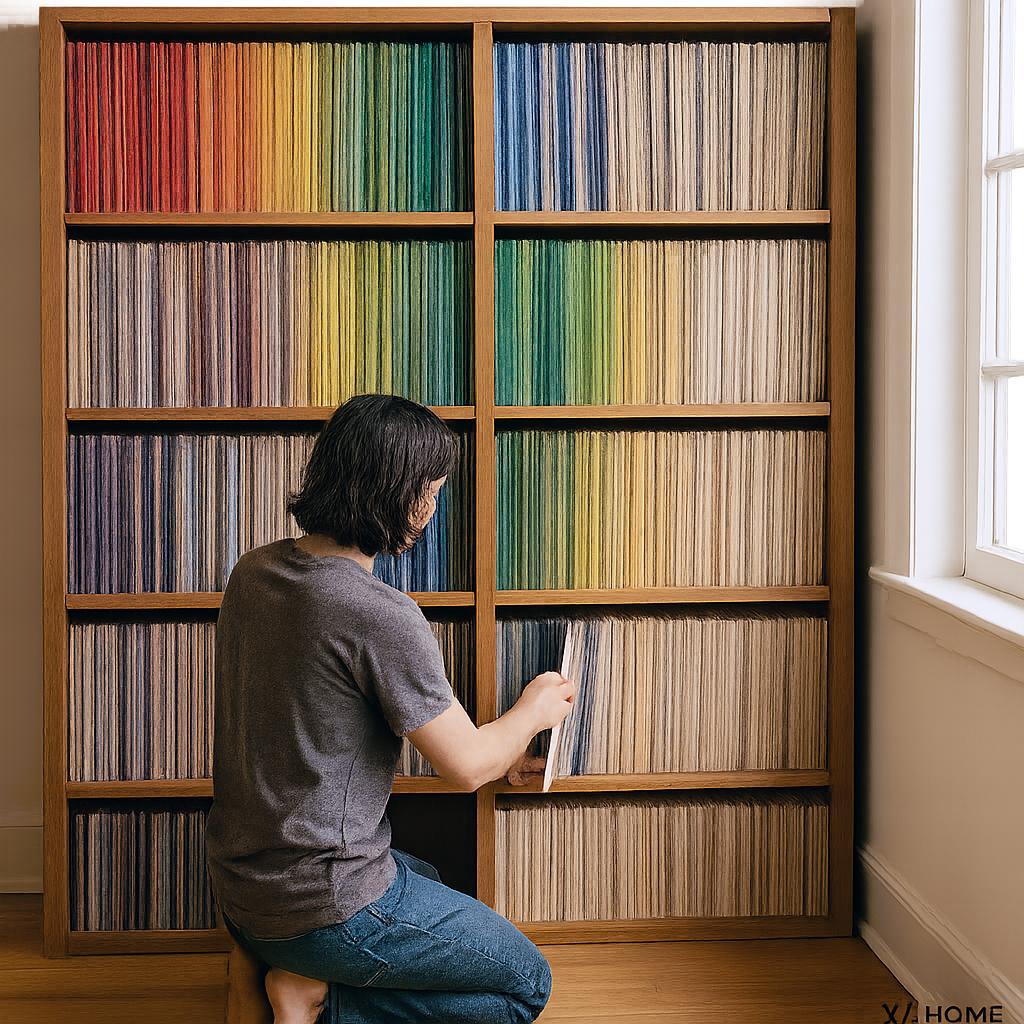There's a certain magic to the unwavering pitch of a well-played piano note, the sustained cry of a saxophone, or the steady pulse of a synth pad. When that stability is compromised in vinyl playback, when notes seem to waver, bend, or shimmer unnaturally, you've likely encountered the unwelcome duo: wow and flutter. These are not mere audiophile nitpicks; they are fundamental distortions of musical pitch and timing that can significantly detract from your listening pleasure.
At XJ-HOME, we believe that achieving a faithful reproduction of the recorded event is paramount. This means not just capturing timbre and dynamics, but also the unwavering temporal accuracy that allows music to breathe and flow as the artists intended. Understanding, identifying, and rectifying wow and flutter issues is a key step in this pursuit. Let's banish these sonic specters.
Defining the Demons: Wow vs. Flutter
While often grouped together, wow and flutter are distinct phenomena, differing primarily in the rate of speed variation:
-
Wow: This refers to slow, cyclical speed variations, typically below 4-6 Hz. The audible effect is a gentle, once-per-revolution (or slower) rise and fall in pitch. Think of a sustained piano note slowly going "woooow-woooow" in pitch. It can make music sound seasick or lethargic.
-
Flutter: This describes rapid speed variations, typically above 4-6 Hz. The audible effect is a more rapid, shimmering, or gargling quality to sustained notes. It can make instruments sound watery, add a roughness to the sound, or make cymbals sound like they're being "gargled." High-frequency flutter can be particularly irritating.
Scrape Flutter: A less common but related issue, often caused by the stylus physically dragging or sticking in a damaged or contaminated groove, leading to a harsh, scraping sound and severe pitch instability. This is usually a record condition issue rather than a turntable mechanism fault.
The Audible Evidence: How Wow & Flutter Betray Themselves
Your ears are often the first line of defense. Listen critically, especially to:
-
Sustained Notes: Piano, organ, synthesizers, solo wind instruments, and long vocal notes are particularly revealing. Do they hold pitch steadily, or do they exhibit a slow wavering (wow) or a faster shimmer/gargle (flutter)?
-
Musical Attack and Decay: Flutter can sometimes smear the attack of notes or add an unnatural texture to their decay.
-
Overall Rhythmic Stability: While harder to pinpoint, severe wow can sometimes impact the perceived "drive" or "solidity" of the rhythm.
-
A Sense of "Unease": Sometimes, even if you can't precisely identify it as wow or flutter, a general sense that something is "off" with the pitch or timing can be an indicator.
Tools of Detection: Beyond Just Listening
While your ears are crucial, more objective methods can confirm your suspicions and help quantify the problem:
-
Test Records:
-
Many analog test LPs (e.g., Hi-Fi News Analogue Test LP, Ortofon Test Record, Analogue Productions Ultimate Analogue Test LP) include specific tracks with sustained tones (often 3150 Hz or 1000 Hz) designed for wow and flutter measurement.
-
You listen for audible wavering or use analysis software in conjunction with these tones.
-
-
Stroboscope Discs & Lights:
-
A stroboscope disc has precise markings around its edge. When viewed under a light source flickering at a specific frequency (e.g., your mains frequency of 50Hz or 60Hz), the markings should appear stationary if the turntable speed is correct and stable.
-
If the markings drift slowly back and forth, it indicates wow. If they appear to jitter or blur rapidly, it can indicate flutter.
-
Many turntables have built-in stroboscopes and pitch controls. External stroboscope discs and dedicated strobe lights are also available.
-
-
Smartphone Apps & Software:
-
There are apps (e.g., "RPM Speed & Wow" for iOS/Android, Turntable Speed for Android) that use the phone's accelerometer or microphone to analyze turntable speed and estimate wow/flutter. Place the phone on the platter (centered, often without a record for best results with accelerometers) or near the speaker.
-
Computer software (like Audacity, or dedicated analysis tools like WFGUI) can record the output of a test tone from your turntable and perform a detailed wow and flutter analysis. This is often the most accurate DIY method. You'd record the 3150Hz tone from a test record and the software analyzes its frequency variations.
-
A Word of Caution: The accuracy of phone apps can vary depending on the phone's sensors and how it's used. Software analysis with a good test record signal is generally more reliable.
-
-
Professional Measurement Tools:
-
Dedicated wow and flutter meters (like those from Leader or Kenwood, often found in vintage audio repair shops) provide precise, standardized measurements (e.g., WRMS, DIN). This is the domain of technicians and serious hobbyists.
-
Unmasking the Culprits: Common Causes of Wow & Flutter
Once identified, the hunt for the cause begins. Here are the usual suspects:
A. Belt-Related Issues (for Belt-Drive Turntables):
-
Worn, Stretched, or Loose Belt: The most common culprit. A belt that has lost its elasticity or proper tension cannot maintain consistent speed.
-
Fix: Replace the belt with a new one of the correct specification for your turntable model.
-
-
Incorrect Belt: Using a belt that's too thick, too thin, too long, or too short will cause problems.
-
Fix: Always use the manufacturer-recommended belt.
-
-
Dirty Belt or Pulleys: Oil, dust, or grime on the belt or motor pulley/platter rim can cause slippage or uneven grip.
-
Fix: Clean the belt (if rubber, with isopropyl alcohol on a lint-free cloth, very gently) and the pulley/platter drive surfaces thoroughly with isopropyl alcohol. Ensure they are completely dry before reinstalling.
-
-
Twisted or Improperly Seated Belt: Ensure the belt is flat and riding correctly on the crown of the motor pulley and the platter's drive surface.
-
Fix: Re-seat the belt correctly.
-
B. Motor Issues:
-
Dirty or Dry Motor Bearings/Spindle: Lack of lubrication or contamination can cause the motor to run erratically or cog.
-
Fix: This is more advanced. Some motors can be carefully cleaned and lubricated with specific oils (e.g., light synthetic motor oil, sewing machine oil – always check manufacturer recommendations or service manuals). Some motors are sealed and not user-serviceable.
-
-
Failing Motor or Motor Control Circuitry: Electronic components in the motor or its power supply/speed control can degrade over time.
-
Fix: This usually requires professional diagnosis and repair/replacement.
-
-
Loose Motor Mountings: If the motor isn't securely mounted, it can vibrate excessively.
-
Fix: Check and tighten motor mounting screws.
-
C. Platter & Bearing Issues:
-
Dirty or Dry Main Platter Bearing: The bearing well where the platter spindle sits needs to be clean and properly lubricated for smooth, consistent rotation.
-
Fix: Clean the bearing well and spindle thoroughly (e.g., with isopropyl alcohol and lint-free swabs). Re-lubricate with the manufacturer-specified bearing oil (e.g., synthetic oils with specific viscosity, like those from Rega, Pro-Ject, or specialized turntable oil suppliers). Do not over-lubricate.
-
-
Worn Main Platter Bearing: Over time, the bearing can wear, leading to play or roughness.
-
Fix: This usually requires replacement of the bearing assembly, often a job for a technician.
-
-
Warped Platter: Though rare, a physically warped platter will cause obvious problems.
-
Fix: Platter replacement.
-
-
Unbalanced Platter: If the platter isn't properly balanced, it can contribute to rotational instability.
-
Fix: Usually a manufacturing defect; platter replacement.
-
-
Record Mat Issues: A mat that is slipping, not flat, or of an inappropriate material/thickness can sometimes contribute.
-
Fix: Ensure the mat is clean, flat, and suitable for your platter.
-
D. Record-Related Issues:
-
Off-Center Spindle Hole: If the hole in the record isn't perfectly centered, the stylus will trace a path that causes cyclical pitch variations (wow).
-
Fix: Some enthusiasts use a "record hole reamer" to very carefully enlarge the hole slightly, allowing the record to be manually centered on the platter before play. This is a delicate operation. Otherwise, you live with it for that specific record.
-
-
Warped Records: A significantly warped record will cause the stylus to ride up and down, changing the effective tracking speed and causing wow.
-
Fix: Use a record clamp or weight (if your turntable bearing can support it) to help flatten minor warps against the platter. For more severe warps, record flattening devices exist, or the record may be unplayable without audible issues. (See our previous post on preventing warping!)
-
E. External & Setup Factors:
-
Unstable Surface / Vibrations: If the turntable isn't on a solid, level, and vibration-damped surface, external vibrations can interfere with its speed stability.
-
Fix: Ensure your turntable is on a dedicated, rigid shelf or stand, away from foot traffic and speakers. Consider isolation platforms or feet.
-
-
Incorrect Stylus Tracking Force (VTF): While not a primary cause, grossly incorrect VTF can affect how the stylus interacts with the groove, potentially exacerbating other minor instabilities.
-
Fix: Ensure VTF is set correctly according to your cartridge manufacturer's specifications.
-
The Pursuit of Steadfast Pitch
Eliminating wow and flutter, or at least minimizing them to inaudible levels, is a hallmark of a well-maintained and properly set-up turntable. It requires patience, careful observation, and a systematic approach to diagnosis. Start with the simplest and most common culprits (like the belt and cleaning) before moving to more complex potential issues.
For those seeking the utmost in speed stability, some high-end turntables employ sophisticated external power supplies and motor control systems. Understanding these principles can also guide you when considering an upgrade. For further reading on turntable mechanics and the science of audio, the resources available on sites like the Audio Engineering Society (AES) E-Library can offer incredibly deep insights, though often quite technical.
The reward for your diligence is a listening experience where the music flows with the unwavering pitch and rhythmic integrity the artists intended – a truly satisfying state of analog playback.
What are your go-to methods for diagnosing or fixing wow and flutter? Share your experiences in the comments below!





Leave a comment
All comments are moderated before being published.
This site is protected by hCaptcha and the hCaptcha Privacy Policy and Terms of Service apply.